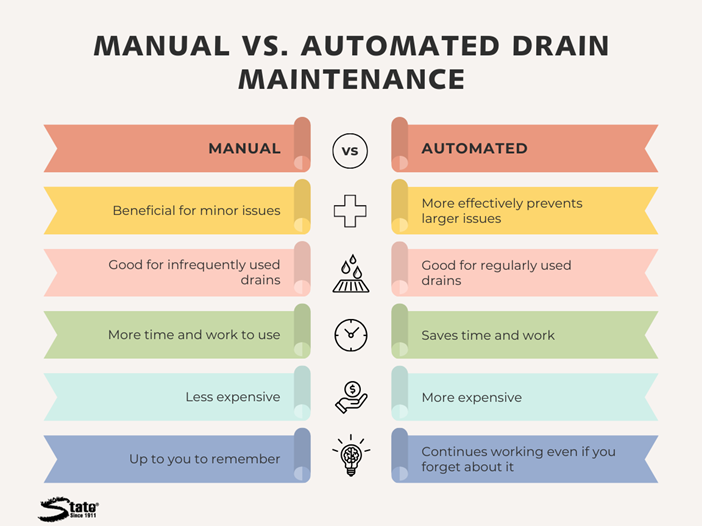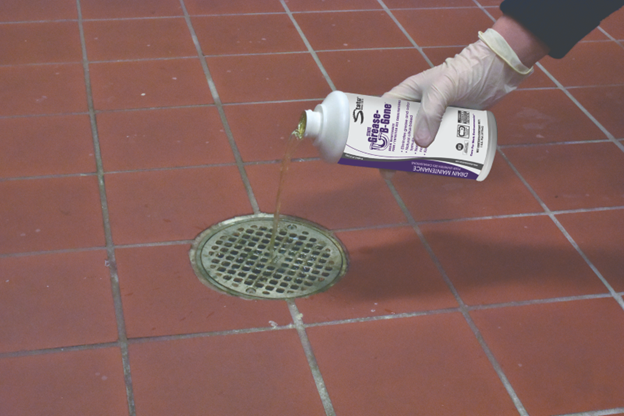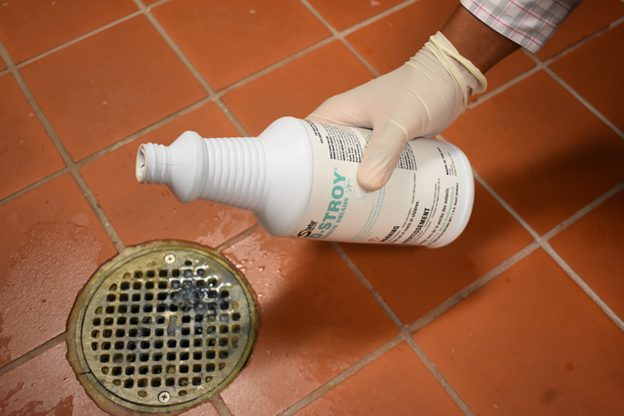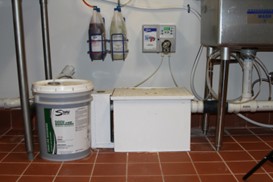Is a Drain Feed Pump Worth It?
Is a Drain Feed Pump Worth It?
Picture this: your facility invests in a brand-new drain maintenance program. As the facility manager, you’re excited to see the end of your drain woes and have more time to focus on business. All you have to do is pour 10 ounces of product down your drain every night before you go home.
But on busy nights, it’s easy to forget. You’re not there every day, and sometimes, employees fail to check it off the list of closing tasks. Suddenly, it’s been 30 days since you started this program, and you’ve only used 25% of the product that you were supposed to empty by now—and your drains are experiencing the same backups as always.
As a chemical solutions manufacturer and distributor, State Chemical offers several lines of drain maintainers and multiple automated maintenance options. We know that clean drains are by no means your only focus when you’re busy running a business, so it’s our goal to provide you with accurate information about drain care so that you don’t have to think about it.
Therefore, we’ve taken the time to compare manual and automated drain maintenance. After reading, you’ll know what the best purchase is for your facility.
What is Manual Drain Maintenance?
When we say manual drain maintenance, we’re talking about pouring chemical drain maintainers down your drain by hand. In this system, you’ll receive a bottle of product, and it’s then a daily, weekly, or monthly task (depending on the severity of your drain problems) for you to put it down your drain.
Drain maintainers can be used in all drains because all drains experience buildup. Some may be used to break down fats, oils, and greases (FOGs), some may treat dry drain, and others may target drain fly habitats. Regardless of the specific issue, drains benefit from maintenance because problems are only a matter of time if they're not maintained.
The Pros and Cons of Manual Drain Maintenance
Preventative drain maintenance is essential when you’re running a business, but what are the benefits and drawbacks of doing it manually?
Pro: Manual Drain Maintenance Can Be Beneficial for Minor Issues and Infrequently Used Drains
When you’re looking at a minor drain problem, you don’t necessarily need the frequent maintenance provided by a feed pump. For example, if your FOG buildup is mild enough to usually go undetected even without drain maintenance, a feed pump would be an overuse of product and an unnecessary expense. Instead, pouring a drain maintainer down your drain once a month, for example, makes more sense.
Similarly, if your drains aren’t consistently used, it doesn’t make sense to set up a pump to feed FOG-clearing chemicals into a drain that hasn’t seen FOGs in weeks.
Let’s imagine that you have a few floor drains, for example. They’re further off from the sinks, so the only time they tend to see much drainage is when you mop. Without water consistently flowing, you’ll probably run into issues with dry drain, which is when your drains produce foul odors due to sewer gases escaping with underuse.
This is another case where you’d be better off with manual maintenance. You could very occasionally pour a drain maintainer for dry drain into your floor drains to provide the best upkeep without overusing product or wasting money.
Con: Manual Drain Maintenance Means Drain Care is Up to You to Remember
However, if your drains experience a standard amount of buildup and are frequently used, you’ll also need to use your drain maintainer more regularly. And if you opt for manual maintenance, this schedule will be up to you to remember and implement.
With all your responsibilities, staff size limitations, and general busyness, it can be harder than you might think to complete this manual maintenance consistently. After a long day, it might slip your mind. And when you build a habit of forgetting, your drains will not be maintained, and drain issues will begin to surface.
Pro: Manual Drain Maintenance Can Sometimes Be Less Expensive
This considered, if you can keep a consistent schedule or if you have more minor problems, manual maintenance is typically less expensive than automated maintenance.
With automated maintenance, you have to pay for the feed pump and its upkeep (e.g., battery replacement, service, labor costs, etc.). Meanwhile, with manual maintenance, you’re only paying for the drain maintenance product itself.
If you have the means to manage the product yourself and are working on a tighter budget, manual maintenance is for you.
Con: Manual Drain Maintenance Takes Longer and is More Work
Another factor to consider is that manually maintaining your drains will take longer and involve more work. Each time you need to pour product down your drains (usually once a day), you’ll have to put on proper personal protective equipment (PPE), gain access to the drain, measure out the correct amount of product, pour it down, and follow any other product directions.
This isn’t the end of the world by any means, but the task can be tedious when you’re busy and could be using an automated system rather than investing your time in it.
What is Automated Drain Maintenance?
Meanwhile, automated drain maintenance involves using a computerized feed pump to maintain your drains. You can program the pump to release a certain amount of product into your drain at whatever frequency you require, and then it works to keep your lines clear.
The Pros and Cons of Automated Drain Maintenance
As with manual maintenance, automated maintenance has both pros and cons depending on your preferences.
Pro: Automated Drain Maintenance Saves You Time and Work
Above anything else, the selling point of automated drain maintenance is that it saves time, work, and a headache. You don’t have to deal with scheduling anything or wondering if you forgot to pour the maintainer last night—instead, the feed pump does it all for you.
Con: Automated Drain Maintenance Isn’t Necessary for Infrequently Used Drains
One important consideration is the severity of your drain problems. If you need maintenance less than once a week, manual maintenance might be a better option.
Automated maintenance is great for doing the work for you, but when there’s not enough work for it to do, it’s probably not worth the investment. If you aren’t sure what the best option for you is, you can also have your site surveyed to determine the severity of your drain issues and which kind of maintenance you need.
Pro: Automated Drain Maintenance Occurs Regularly and Prevents Larger Issues
A benefit of automated maintenance is simple: drain pumps work even if you forget. Because they’re programmed to release product on a set schedule, you need not worry about whether the job is actually getting done.
Because of this regular schedule, you’ll more effectively prevent larger issues. Regular maintenance means regular treatment, with the drain pump as an employee that never gets sick, never takes a day off, and never misses a task. It’s guaranteed treatment, which is especially useful for industries that can’t afford the fallout of larger drain issues.
For example, let’s imagine that you’re a hospital's food service manager. If a drain backs up, you’ll have to stop cooking for the whole hospital until the issue is resolved. This situation requires an automated drain maintenance system; your facility simply can’t afford the fallout of a serious problem.
Con: Automated Drain Maintenance Can Be More Expensive
Unfortunately, convenience usually goes hand in hand with higher expenses. With an automated system, you will be looking at higher price tags than if you were only buying the product.
If your issues are severe, compare to the cost of reactive maintenance to determine whether automated maintenance is an option for you. But if your facility is on a tighter budget and this isn’t a possibility, you’ll just need to develop a consistent routine for conducting manual maintenance.
Your Next Step: Use Manual Maintenance for Infrequently Used Drains, Invest in Automated Maintenance for Standard Drains
It’s easy to add more work to your own plate to avoid additional expenses, but ultimately, it’s important to be realistic and consider whether you can actually work manual maintenance into your schedule. If you can and/or your drains are used infrequently, manual maintenance is a feasible option for you. If your buildup is severe and/or you can’t consistently treat your drains yourself, invest in automated maintenance.
Now that you know which option is best for you, your next step is to consider the cost of a drain care contract with State Chemical.












